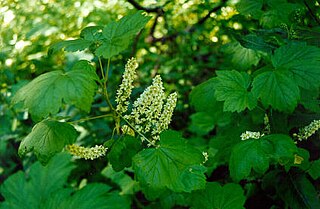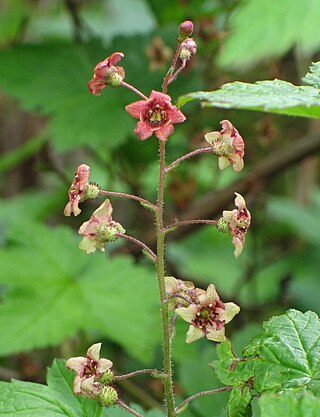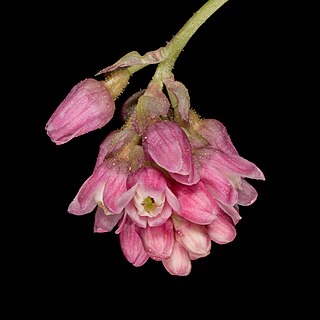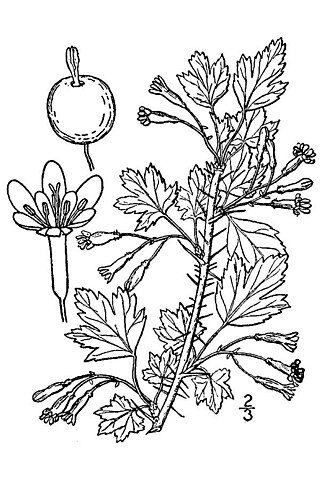
Ribes is a genus of about 200 known species of flowering plants, most of them native to the temperate regions of the Northern Hemisphere. The species may be known as various kinds of currants, such as redcurrants, blackcurrants, and whitecurrants, or as gooseberries, and some are cultivated for their edible fruit or as ornamental plants. Ribes is the only genus in the family Grossulariaceae.

Ribes sanguineum, the flowering currant, redflower currant, red-flowering currant, or red currant is a North American species of flowering plant in the family Grossulariaceae, native to the western United States and Canada.

Ribes menziesii, the canyon gooseberry, is a species of currant found only in California and Oregon. There are five to six varieties of the species found across the low elevation mountains of California, especially the Coast Ranges, and the coastal canyons and foothills, into southern Oregon. It can be found in the chaparral plant community.

Garberia is a monotypic genus of flowering plants in the family Asteraceae, containing the single species Garberia heterophylla. It is endemic to Florida in the United States, where it is distributed in the northern and central counties. The plant is known commonly as garberia and Garber's scrub starts.
Nemophila breviflora is a species of flowering plant in the borage family known by the common names basin nemophila, Great Basin nemophila, and Great Basin baby-blue-eyes. It is native to southwestern Canada and the northwestern United States, where it generally grows in wooded and forested areas in thickets and moist streambanks.

Ribes speciosum is a species of flowering plant in the family Grossulariaceae, which includes the edible currants and gooseberries. It is a spiny deciduous shrub with spring-flowering, elongate red flowers that resemble fuchsias, though it is not closely related. Its common name is fuchsia-flowered gooseberry. It is native to central and southern California and Baja California, where it grows in the scrub and chaparral of the coastal mountain ranges.
Ribes binominatum is a species of currant known by the common names trailing gooseberry and ground gooseberry.

Ribes cereum is a species of currant known by the common names wax currant and squaw currant; the pedicellare variety is known as whisky currant. The species is native to western North America.

Ribes hudsonianum is a North American species of currant, known by the common name northern black currant.

Ribes indecorum is a species of currant known by the common names white-flowered currant and white chaparral currant. It is native to the southern California Coast Ranges, Transverse Ranges, and Peninsular Ranges, from around Santa Barbara County in California south into northern Baja California.

Ribes laxiflorum is a species of currant known by the common names trailing black currant, and spreading currant. It is native to western North America.

Ribes nevadense is a species of currant known by the common names Sierra currant and mountain pink currant.

Ribes roezlii is a North American species of gooseberry known by the common name Sierra gooseberry.

Ribes sericeum is a species of currant known by the common name Lucia gooseberry, or Santa Lucia gooseberry; its Latin epithet of sericeum means "of silk". It is endemic to California, where it is known only from the Santa Lucia Mountains along the Central Coast and an additional isolated population in Santa Barbara County.

Ribes velutinum is a species of currant known by the common name desert gooseberry.
Ribes victoris is an uncommon North American species of currant known by the common name Victor's gooseberry. It is endemic to California, where it grows in the chaparral and woods of canyons in the San Francisco Bay Area and counties to the north, as far as Humboldt County.

Galearis rotundifolia is a species of flowering plants in the orchid family, Orchidaceae. It is commonly called roundleaf orchid and small round-leaved orchid. It is a succulent perennial herb native to North America, where it occurs throughout Canada, part of the northern United States, and Greenland.

Ribes americanum is a North American species of flowering plant in the gooseberry family known as wild black currant, American black currant, and eastern black currant. It is widespread in much of Canada and the northern United States.

Ribes oxyacanthoides is a species of flowering plant in the gooseberry family known by the common name Canadian gooseberry. Its various subspecies have common names of their own. It is native to North America, where it occurs in Alaska through much of Canada and the western and north-central United States.

















